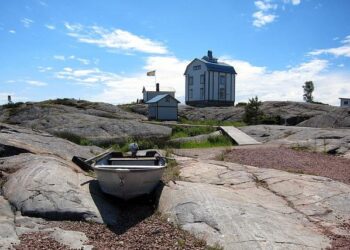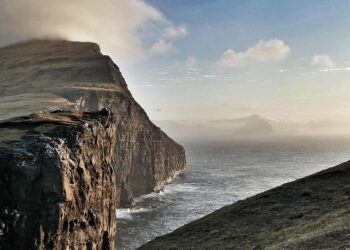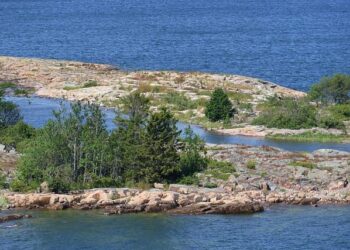A recent study published in Frontiers sheds new light on the subtle footprints of human activity on the Ă…land Islands through innovative palynological and correlation analyses. By examining pollen records and other environmental indicators, researchers have traced evidence of small-scale land use shaping this unique archipelago’s landscape over centuries. This breakthrough not only deepens our understanding of historical land management practices in the region but also highlights the intricate relationship between humans and their environment on a micro-regional scale.
Tracing Human Impact on Ă…land Islands Reveals Patterns in Small-Scale Land Use
The detailed palynological analyses conducted on sediment cores recovered from various locations across the Ă…land Islands have shed light on the intricate dynamics of human-environment interaction. Microscopic pollen assemblages reveal fluctuations in vegetation cover that correspond closely to periods of intensified agricultural activity, deforestation, and land abandonment. These results underscore the persistent, albeit small-scale, land use strategies employed by past inhabitants, which have cumulatively shaped the island’s ecological footprint over centuries. Notably, the presence of cereal pollen alongside ruderal species highlights a mosaic landscape, where cultivated fields intertwined with natural or semi-natural habitats.
Correlation studies between palynological data and historical records further elucidate the timing and extent of anthropogenic influence. Key findings include:
- Increased pollen from crop plants coincides with documented settlement expansions in the Medieval period.
- Rise in charcoal particles aligns with periods of forest clearance and traditional slash-and-burn agriculture.
- Shifts in tree pollen percentages reflect cycles of land regeneration following agricultural decline.
| Timeframe | Dominant Pollen Types | Inferred Land Use |
|---|---|---|
| 500-800 AD | Oak, hazel, cereals | Early cultivation and clearing |
| 1100-1400 AD | Ruderal herbs, charcoal | Intensified slash-and-burn farming |
| 1600-1900 AD | Pine, birch, grasses | Land abandonment and regrowth |
Palynological Evidence Uncovers Historical Vegetation Changes Linked to Anthropogenic Activities
Recent palynological investigations on the Ă…land Islands have meticulously charted shifts in vegetation patterns that correspond strongly with periods of intensified human activity. Analysis of pollen samples extracted from sediment cores reveals clear signs of landscape alteration, primarily driven by small-scale agricultural practices and woodland management. Notably, increased frequencies of cereal pollen and ruderal plant species suggest the expansion of cultivated plots and the disruption of native flora through tillage and grazing. These botanical indicators are bolstered by the presence of charcoal particles, which point to controlled burning-a common land clearance method employed by early settlers.
By correlating these palynological data with archaeological findings and historical records, researchers have been able to construct a timeline detailing the dynamic interaction between humans and their environment. Key observations include:
- Post-medieval intensification: Sharp rises in cereal pollen indicating crop diversification and improved land use efficiency.
- Decline of forest species: Gradual reduction in tree pollen, especially of boreal conifers, reflecting sustained deforestation.
- Emergence of ruderal taxa: Species typically associated with disturbed soils coincide with phases of settlement expansion.
| Time Period | Pollen Indicator | Interpretation |
|---|---|---|
| 1000-1200 AD | Increase in Poaceae & Cerealia | Onset of sustained small-scale cultivation |
| 1200-1500 AD | Rise in Plantago & Rumex | Expansion of disturbed grazing areas |
| 1500-1800 AD | Decline in Pinus & Betula | Forest clearance for agriculture |
Recommendations for Sustainable Land Management Based on Correlation Analysis Findings
Grounded in the correlation analysis, the evidence highlights that sustainable land management on the Ă…land Islands hinges on balancing small-scale agricultural practices with ecological integrity. Key anthropogenic indicators suggest that maintaining biodiversity-rich buffer zones and minimizing soil disturbance significantly curb the degradation trends observed in highly cultivated parcels. Implementing rotational grazing and reduced tillage emerges as an effective approach to sustain soil health while supporting traditional land use patterns cherished by local communities.
Furthermore, the data advocates for proactive stakeholder collaboration, especially involving farmers and conservationists, to tailor adaptive strategies suited to the island’s unique palynological context. The following focal points summarize immediate actions to enhance sustainable land stewardship:
- Promote agroforestry systems integrating native tree species to improve carbon sequestration and habitat connectivity.
- Encourage organic farming to reduce chemical inputs, thereby preserving pollen diversity and soil microbiota.
- Establish monitoring programs using pollen indicators to dynamically assess land use impacts over time.
| Indicator | Recommended Practice | Expected Benefit |
|---|---|---|
| Decreased arboreal pollen | Buffer zone enhancement | Improved erosion control |
| Increased cereal pollen | Rotational cropping | Soil fertility maintenance |
| High ruderal pollen | Organic weed management | Biodiversity preservation |
To Wrap It Up
In shedding new light on the subtle footprints of human activity on the Ă…land Islands, this study underscores the value of palynological and correlation analyses in unraveling the history of small-scale land use. As researchers continue to decode these environmental archives, the findings not only enrich our understanding of regional anthropogenic impacts but also highlight the intricate relationship between human communities and their landscapes over time. This growing knowledge base promises to inform future conservation and land management efforts in the Ă…land archipelago and similar regions worldwide.
















